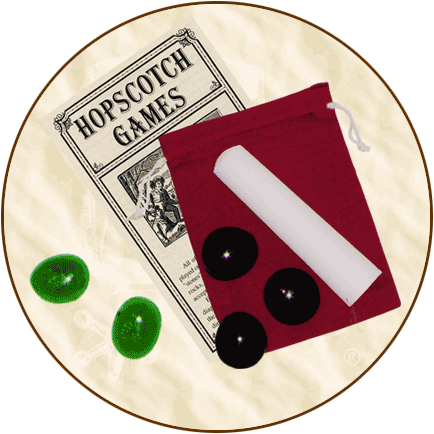.
Continued from product description on
Traditional Games' Page Two...
Historical
Background: According to most sources, hopscotch was developed
centuries ago in Great Britain during the Roman occupation. Because
the original hopscotch courts were used for military training,
they were over 100 feet long! These long courts represented the
long 400-mile journey on the Great North Road connecting London,
England, to Glasgow, Scotland. Roman soldiers used this road
frequently, so a military exercise was developed to condition
them for it. Roman soldiers tested their strength on these hopscotch
courts by carrying heavy loads or wearing full armor. Today,
football players go through similar conditioning drills by running
through rows of truck tires in full gear.
It is reported that Roman children made their own smaller
courts to imitate the soldiers. The children developed a scoring
system for their games, and hopscotch was born and spread throughout
Europe. The word "hop scotch" literally came from hopping
the long road to Glasgow, Scotland. Various cultures have developed
their own games with different courts and rules. Other words
for hopscotch are: "marelles" (France), "templehupfen"
(Germany), "hinkelbaan" (The Netherlands), "ekaria
dukaria" (India), "pico" (Vietnam), and "rayuela"
(Argentina).
Most hopscotch games are played with a "puck" or
"potsey." The puck can be a stone, rock, a piece of
flat glass, crockery, or just about anything that can be thrown
onto the courts. The courts can be drawn with chalk on a concrete
surface or with a stick on a bare spot of level ground. Generally,
hopscotch games are played by tossing the puck into a drawn section
and hopping in a specific way through the court and back. There
are rules against stepping on a line, missing a square, or losing
your balance and touching the court with a hand. The first person
to complete the course is the winner.
Today, we think of Hopscotch as a children's game, particularly
for girls. The game of Hopscotch is featured in "The Boy's
Own Book" by William Clark, first published in 1829. This
book was considered "A popular encyclopedia of the sports
and pastimes of youth." Interestingly, the game of hopscotch
is not featured in "The Girl's Own Book" by L. Maria
Child, published in 1834. Hopscotch was considered a boy's game,
as depicted by five boys playing the game in the illustration
"Scotch Hoppers" from "Juvenile Games for the
Four Seasons."













